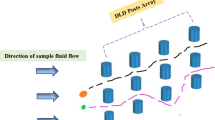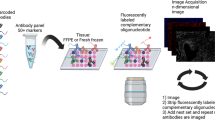Abstract
Introduction
While single-cell analysis technology has flourished, obtaining single cells from complex tissues continues to be a challenge. Current methods require multiple steps and several hours of processing. This study investigates chemical and mechanical methods for clinically relevant preparation of single-cell suspension from frozen biopsy cores of complex tissues. The developed protocol can be completed in 15 min.
Methods
Frozen bovine liver biopsy cores were normalized by weight, dimension, and calculated cellular composition. Various chemical reagents were tested for their capability to dissociate the tissue via confocal microscopy, hemocytometry and quantitative flow cytometry. Images were processed using ImageJ. Quantitative flow cytometry with gating analysis was also used for the analysis of dissociation. Physical modeling simulations were conducted in COMSOL Multiphysics.
Results
A rapid method for tissue dissociation was developed for single-cell analysis techniques. The results of this study show that a combination of 1% type-1 collagenase and pronase or hyaluronidase in 100 U/µL HBSS solution is the most effective at dissociating 2.5 mm thawed bovine liver biopsy cores in 15 min, with dissociation efficiency of 37-42% and viability >90% as verified using live MDA-MB-231 cancer cells. Cellular dissociation is significantly improved by adding a controlled mechanical force during the chemical process, to dissociate 93 ± 8% of the entire tissue into single cells.
Conclusions
Understanding cellular dissociation in ex vivo tissues is essential to the development of clinically relevant dissociation workflows. Controlled mechanical force in combination with chemical treatment produces high quality tissue dissociation. This research is relevant to the understanding and assessment of tissue dissociation and the establishment of an automated preparatory workflow for single cell diagnostics.









Similar content being viewed by others
References
Alles, J., Karaiskos, N., Praktiknjo, S.D., Grosswendt, S., Wahle, P., Ruffault, P.L., Ayoub, S., Schreyer, L., Boltengagen, A., Birchmeier, C. and Zinzen, R. Cell fixation and preservation for droplet-based single-cell transcriptomics. BMC Biol. 15(1)44. 2017.
Amsterdam, A., T. E. Solomon, and J. D. Jamieson. Sequential dissociation of the exocrine pancreas. Methods in cell biol. 20:361, 1978.
Blow, N. Biobanking: freezer burn. Nat. Methods 6(2):173–178, 2009.
Cunningham, R. E. Tissue Disaggregation. Immunocytochemical Methods and Protocols 327-330. New York: Humana Press, 2010.
Elattar, T. M., and A. S. Virji. The inhibitory effect of curcumin, genistein, quercetin and cisplatin on the growth of oral cancer cells in vitro. Anticancer Res. 20(3A):1733–1738, 2000.
Freyer, J. P., and R. M. Sutherland. Selective dissociation and characterization of cells from different regions of multicell tumor spheroids. Cancer Res. 40(11):3956–3965, 1980.
Heslin, M. J., J. J. Lewis, J. M. Woodruff, and M. F. Brennan. Core needle biopsy for diagnosis of extremity soft tissue sarcoma. Ann. Surg. Oncol. 4(5):425–431, 1997.
Hwang, B., J. H. Lee, and D. Bang. Single-cell RNA sequencing technologies and bioinformatics pipelines. Exp. Mol. Med. 50(8):1–14, 2018.
Jager, L. D., C. M. A. Canda, C. A. Hall, C. L. Heilingoetter, J. Huynh, S. S. Kwok, J. H. Kwon, J. R. Richie, and M. B. Jensen. Effect of enzymatic and mechanical methods of dissociation on neural progenitor cells derived from induced pluripotent stem cells. Adv. Med. Sci. 61(1):78–84, 2016.
Jermyn, M., Mok, K., Mercier, J., Desroches, J., Pichette, J., Saint-Arnaud, K., Bernstein, L., Guiot, M.C., Petrecca, K. and Leblond, F., Intraoperative brain cancer detection with Raman spectroscopy in humans. Sci Transl Med, 7(274)274ra19-274ra19. 2015.
Junatas, K. L., Z. Tonar, T. Kubíková, V. Liška, R. Pálek, P. Mik, M. Králíčková, and K. Witter. Stereological analysis of size and density of hepatocytes in the porcine liver. J. Anat. 230(4):575–588, 2017.
Kasserra, H. P., and K. J. Laidler. Mechanisms of action of trypsin and chymotrypsin. Can. J. Chem. 47:4031–4039, 1969.
Kaur, M., and L. Esau. Two-step protocol for preparing adherent cells for high-throughput flow cytometry. Biotechniques 59(3):119–126, 2015.
Kim, J., S. Han, J. Yoon, E. Lee, D. W. Lim, J. Won, J. Y. Byun, and S. Chung. Nanointerstice-driven microflow patterns in physical interrupts. Microfluid Nanofluidics 18(5–6):1433–1438, 2015.
Kim, Y. J., R. L. Sah, J. Y. H. Doong, and A. J. Grodzinsky. Fluorometric assay of DNA in cartilage explants using Hoechst 33258. Anal. Biochem. 174(1):168–176, 1988.
Klein, A.B., Witonsky, S.G., Ansar Ahmed, S., Holladay, S.D., Gogal Jr, R.M., Link, L. and Reilly, C.M. Impact of different cell isolation techniques on lymphocyte viability and function. J Immunoassay Immunochem, 27(1)61-76. 2006.
L. Nestler, E. Evege, J. Mclaughlin, D. Munroe, T. Tan, K. Wagner, and B. Stiles. TrypLE ™ express: a temperature stable replacement for animal trypsin in cell dissociation applications. Quest 1, 2004.
Miller, T. E., Mack, S. C., & Rich, J. N. Mouse cell depletion. Miltenyi Biotec.
Mino-Kenudson, M. Cons: Can liquid biopsy replace tissue biopsy?—the US experience. Transl Lung Cancer Res 5(4):424, 2016.
Rafael, S. C., G. H. Diego, and C. H. F. Javier. Mechanism of action of collagenase clostridium histolyticum for clinical application. Eur. J. Clin. Pharmacol. 18:263–272, 2016.
Sambrook, J. and Russell, D.W. Estimation of cell number by hemocytometry counting. Cold Spring Harbor Protocols, 2006.
Sen, A., M. S. Kallos, and L. A. Behie. New tissue dissociation protocol for scaled-up production of neural stem cells in suspension bioreactors. Tissue Eng. 10(5–6):904–913, 2004.
Shapiro, E., T. Biezuner, and S. Linnarsson. Single-cell sequencing-based technologies will revolutionize whole-organism science. Nat. Rev. Genet. 14(9):618–630, 2013.
Silvestri, G. A., A. V. Gonzalez, M. A. Jantz, M. L. Margolis, M. K. Gould, L. T. Tanoue, L. J. Harris, and F. C. Detterbeck. Methods for staging non-small cell lung cancer: diagnosis and management of lung cancer: American College of Chest Physicians evidence-based clinical practice guidelines. Chest 143(5):e211S–e250S, 2013.
Stenn, K. S., R. Link, G. Moellmann, J. Madri, and E. Kuklinska. Dispase, a neutral protease from Bacillus polymyxa, is a powerful fibronectinase and type IV collagenase. J Invest Dermatol 93(2):287–290, 1989.
Stern, R., and M. J. Jedrzejas. Hyaluronidases: their genomics, structures, and mechanisms of action. Chem. Rev. 106(3):818–839, 2006.
Tirosh, I., B. Izar, S. M. Prakadan, M. H. Wadsworth, D. Treacy, J. J. Trombetta, A. Rotem, C. Rodman, C. Lian, G. Murphy, and M. Fallahi-Sichani. Dissecting the multicellular ecosystem of metastatic melanoma by single-cell RNA-seq. Sci 352(6282):189–196, 2016.
van den Brink, S. C., F. Sage, Á. Vértesy, B. Spanjaard, J. Peterson-Maduro, C. S. Baron, C. Robin, and A. Van Oudenaarden. Single-cell sequencing reveals dissociation-induced gene expression in tissue subpopulations. Nat .Methods 14(10):935, 2017.
Vanharanta, S., and J. Massagué. Origins of metastatic traits. Cancer Cell 24(4):410–421, 2013.
Vekemans, K., and F. Braet. Structural and functional aspects of the liver and liver sinusoidal cells in relation to colon carcinoma metastasis. World J Gastroenterol: WJG 11(33):5095, 2005.
Vembadi, A., Menachery, A. and Qasaimeh, M.A. Cell cytometry: review and perspective on biotechnological advances. Front Bioeng Biotechnol, 7. 2019.
Wang, Y., and N. E. Navin. Advances and applications of single-cell sequencing technologies. Mol. Cell 58(4):598–609, 2015.
Waymouth, C. Tissue Dissociation Guide. Freehold, NJ: Worthington Biochemical, pp. 1–78, 1993.
Wilson, Z. E., A. Rostami-Hodjegan, J. L. Burn, A. Tooley, J. Boyle, S. W. Ellis, and G. T. Tucker. Inter-individual variability in levels of human microsomal protein and hepatocellularity per gram of liver. Br. J. Clin. Pharmacol. 56(4):433–440, 2003.
Wlodkowic, D., and J. M. Cooper. Microfabricated analytical systems for integrated cancer cytomics. Anal. Bioanal. Chem. 398(1):193–209, 2010.
Acknowledgments
We would like to acknowledge the Flow Cytometry Facility, Genomics Core Facility, and Leduc Bioimaging Facility of Brown University for providing the flow cytometer, automated hemocytometer, and confocal microscope used in the study. We would also like to thank the Laboratory of Ian Wong for supplying us with the cancer cells used in the viability assay. We would also like to gratefully acknowledge PerkinElmer for the financial support for this study. AT is a paid scientific advisor/consultant and lecturer for PerkinElmer.
No human studies were carried out by the authors for this article. No animal studies were carried out by the authors for this article.
Conflict of interest
The authors declare that they have no conflict of interest. AT is a paid scientific advisor/consultant and lecturer for PerkinElmer.
Author information
Authors and Affiliations
Corresponding author
Additional information
Associate Editor Guohao Dai oversaw the review of this article.
Publisher's Note
Springer Nature remains neutral with regard to jurisdictional claims in published maps and institutional affiliations.
Supplementary Information
Below is the link to the electronic supplementary material.
Rights and permissions
About this article
Cite this article
Welch, E.C., Yu, H. & Tripathi, A. Optimization of a Clinically Relevant Chemical-Mechanical Tissue Dissociation Workflow for Single-Cell Analysis. Cel. Mol. Bioeng. 14, 241–258 (2021). https://doi.org/10.1007/s12195-021-00667-y
Received:
Accepted:
Published:
Issue Date:
DOI: https://doi.org/10.1007/s12195-021-00667-y




